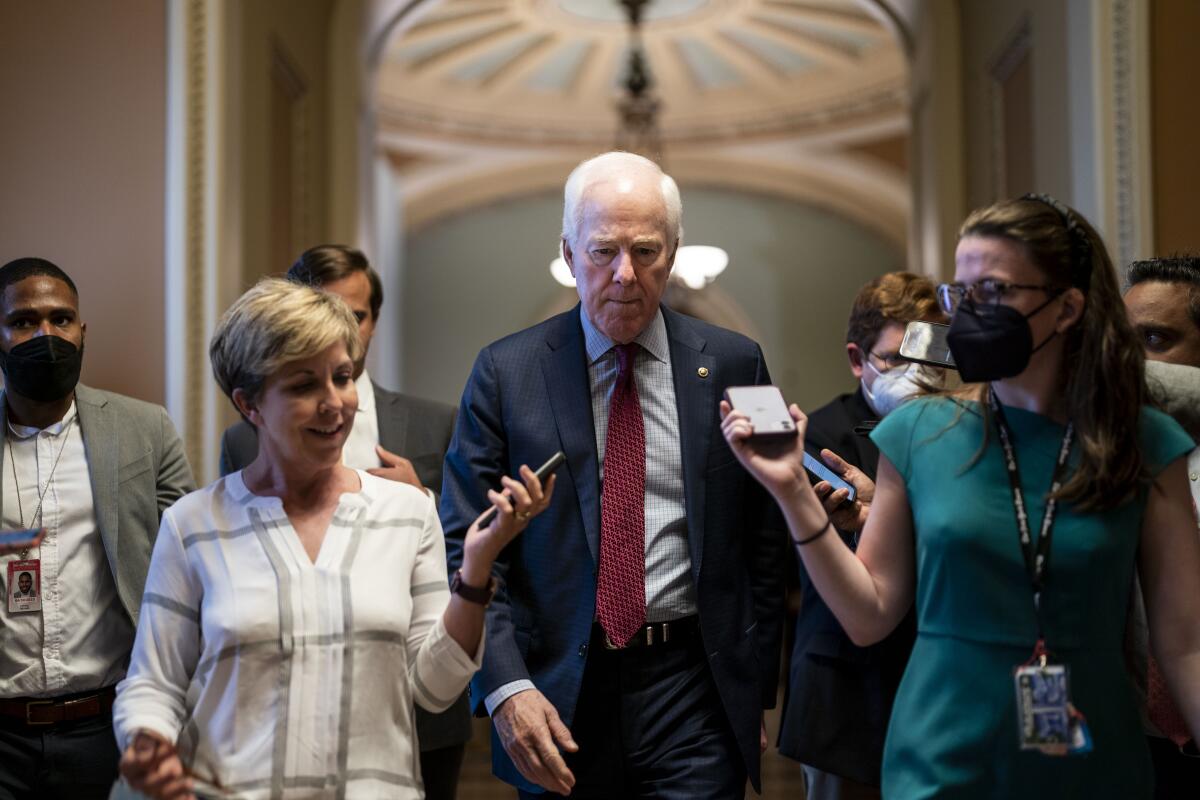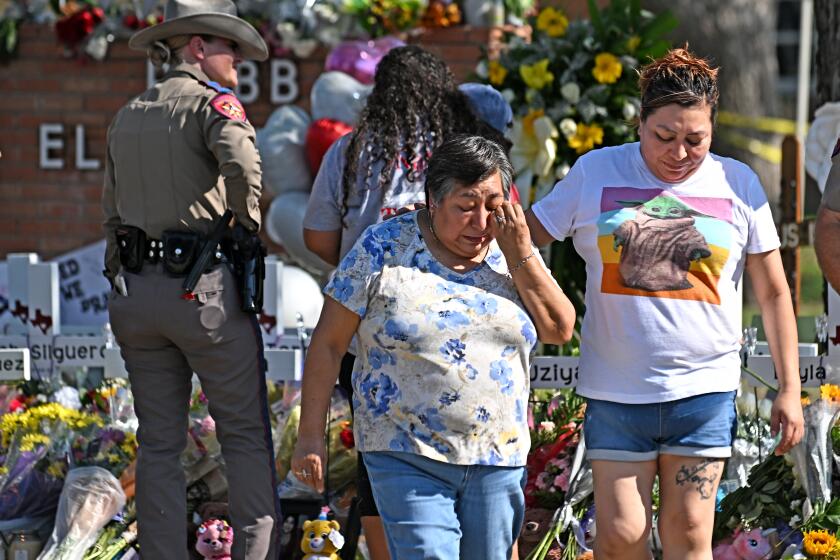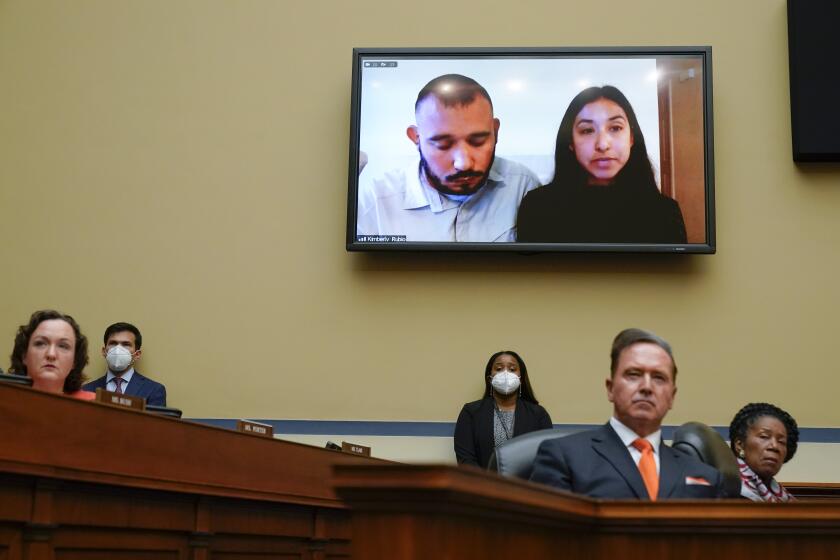The pathetic Senate gun deal is better than nothing — barely

- Share via
Twenty U.S. senators spent much of Sunday and Monday praising themselves for reaching what they called “a commonsense, bipartisan proposal” on federal gun legislation.
The news media and gun safety groups fell into line, observing that the proposal, if enacted by Congress, would be “the most significant national response in decades to acts of mass gun violence,” said John Feinblatt, president of Everytown for Gun Safety.
For the record:
4:11 p.m. June 14, 2022An earlier version of this column at one point said 40 senators agreed on a gun safety proposal. Twenty senators did.
Let’s hope the senators don’t break their arms patting themselves on the back. For anyone interested in enacting truly effective measures to stem the tide of gun violence in this country, the senators’ announcement might be profoundly depressing.
This is the closest in a very long time that the federal government has come to enacting reform that has any chance of having a measurable effect.
— Garen Wintemute, UC Davis
Rather than standing as a bipartisan concord on gun safety, the proposal demonstrates how far we are from achieving genuine gun safety legislation at the federal level.
If this is the best that our federal lawmakers can do in the immediate aftermath of the murders of 19 schoolchildren in Uvalde, Texas, on May 24, and after heart-wrenching, horrifying testimony from the families of victims and a doctor who had to confront the carnage, then we are in a very bad place.
Get the latest from Michael Hiltzik
Commentary on economics and more from a Pulitzer Prize winner.
You may occasionally receive promotional content from the Los Angeles Times.
Let’s further temper the senators’ enthusiasm with a dose of reality: There’s no guarantee that any legislation based on this framework will pass the Senate. In fact, there’s no guarantee that any legislation based on this framework will even be drafted.
The gun lobby knows this. As my colleagues Nolan D. McCaskill and Jennifer Haberkorn reported, the National Rifle Assn. said it would withhold response until the full bill text is released.
But the NRA also said on Twitter that it would “continue to oppose any effort to insert gun control policies, initiatives that override constitutional due process protections & efforts to deprive law-abiding citizens of their fundamental right to protect themselves/loved ones into this or any other legislation” — firing a shot across the bow of the bill drafters, so to speak.
That doesn’t mean that there’s nothing positive in the proposal. Any crack in what has been the GOP’s unyielding opposition to firearms legislation has to be counted as progress.
“I’ve been working in this area for 40 years,” says Garen Wintemute, head of the Violence Prevention Research Program at UC Davis, “and this is the closest in a very long time that the federal government has come to enacting reform that has any chance of having a measurable effect. I’m encouraged by the development.”
Not only our politicians and police are cowards about guns — we all are.
Let’s examine the proposal, as outlined by Sen. Christopher S. Murphy (D-Conn.), who negotiated its terms with Sen. John Cornyn (R-Texas).
The 20 senators who signed on comprise 10 Republicans, nine Democrats and Sen. Angus King of Maine, an independent who caucuses with the Democrats. It’s also proper to note that of the 10 Republicans who signed on, four have already announced their intention not to run for reelection and none of the others are up for reelection this year.
In some respects, the agreement is more notable for what’s omitted than for what’s included.
Much of it isn’t strictly about guns at all. There’s support for mental health services for families and children, including the expansion of mental health services in schools; funding for “school safety resources,” whatever they are; and funding for telehealth programs in mental and behavioral health.
The latter are programs that don’t involve live, face-to-face consultations, which should tell you a little bit about how effective they might be.
These are laudable as far as they go, and most have traditionally garnered GOP support. But mental health has also been wielded by the gun lobby as a catchall explanation for mass shootings that diverts attention from the fundamental problem of easy access to guns.
“The reason to have a better mental health diagnosis and treatment system is simply that the one we have is not good,” Wintemute told me. But using that fact “to prevent other good proposals from going forward is something I object to.”
Statistics suggest that mental illness plays a small role in interpersonal violence, Wintemute says, and people with mental illness are much more vulnerable to being victims of firearm violence than becoming perpetrators.
But mental illness plays a huge role in self-harm and suicide, an aspect of gun violence that is often overshadowed by reports of mass slaughters and other manifestations of our gun culture.
California shows that tough laws can successfully reduce firearm deaths.
As for the actual gun-related provisions in the Senate framework, they don’t go nearly as far as necessary. The agreement would add cases of domestic violence, including convictions and restraining orders, to the federal database for background checks of gun buyers. It also would require a search of juvenile justice and mental health records as part of the background check for buyers under 21.
The agreement would provide resources for states to enact and administer so-called red-flag laws, which can allow family members, co-workers and law enforcement agencies to seek to remove access to guns by individuals identified as a potential danger to themselves or others.
Wintemute’s program has been examining the effectiveness of red-flag orders in California and elsewhere and finds promising evidence that they have prevented violent outbreaks.
Variations on the model have been enacted in 19 states and the District of Columbia, including red states such as Florida and Indiana — most of them following the 2018 mass shooting at Marjory Stoneman Douglas High School in Parkland, Fla. In nine other states, they’ve been rejected, and one, Oklahoma, actually prohibits red-flag laws.
Giving states new resources may overcome some of the persistent problems with red-flag laws, Wintemute says: Many people don’t know they exist, and some law enforcement agencies aren’t well versed in what they say and how to use them.
These proposals don’t cover all the policies that President Biden proposed in a nationally televised prime-time speech delivered after the Uvalde school massacre. In that speech, Biden called for a renewal of the assault weapons ban that Congress enacted in 1994 and allowed to expire in 2004. He also called for expanded background checks and a national red-flag law.
Republicans demand instant action to protect Supreme Court justices. Let’s tie that to an assault weapons ban.
Defenders of the Senate agreement will argue that its small steps will crack open the door to more substantive legislation in the future. That sounds like wishful thinking, as it’s quite conceivable that its drafters will see it as the end of the journey, not the beginning, and will wash their hands of the issue if and when any of its provisions are enacted.
That’s a problem, because the record shows that the way to stem gun violence is through a multifactor package of laws, rather than any individual provisions.
California has achieved a firearm death rate that is among the best in the nation by enacting a comprehensive gun safety policy that encompasses a ban on assault weapons and high-capacity ammunition magazines, a waiting period for gun purchasers and mandatory background checks, bans on the purchase of handguns and some other firearms, a red-flag law and a ban on the purchase of more than one gun a month.
Put them all together, and they prove that gun laws work, without undue infringement of anyone’s 2nd Amendment rights.
The negotiators will defend their agreement in terms of U.S. politics, that this is the least they can do to meet the challenge of a gun culture that takes the slaughter of innocent children in stride.
They’re right. This is the least they can do — the very least, and not enough.
More to Read
Get the latest from Michael Hiltzik
Commentary on economics and more from a Pulitzer Prize winner.
You may occasionally receive promotional content from the Los Angeles Times.














